CHCECE004: Early Childhood Nutrition and Australian Dietary Guidelines
VerifiedAdded on 2019/09/22
|5
|1990
|125
Report
AI Summary
This report delves into the critical aspects of healthy eating and nutrition in Australia, particularly emphasizing the early childhood period. It begins by highlighting Australia's current health risks due to unhealthy eating habits, referencing reports on dietary patterns and nutritional deficiencies among Australians. The report then explores the protein needs of children, emphasizing its significance for growth and development, along with guidelines for creating enjoyable and healthy meal times in childcare programs. It covers the importance of food labels and provides sample meal plans for children, incorporating balanced nutrients. The report also examines the Australian Dietary Guidelines, the National Quality Framework (NQF), National Quality Standard (NQS), and the Early Years Learning Framework (EYLF) and discusses allergy management and the code of ethics for childhood professionals. The information presented aims to guide childcare providers and parents in promoting healthy eating habits and ensuring children receive adequate nutrition for their growth and well-being.
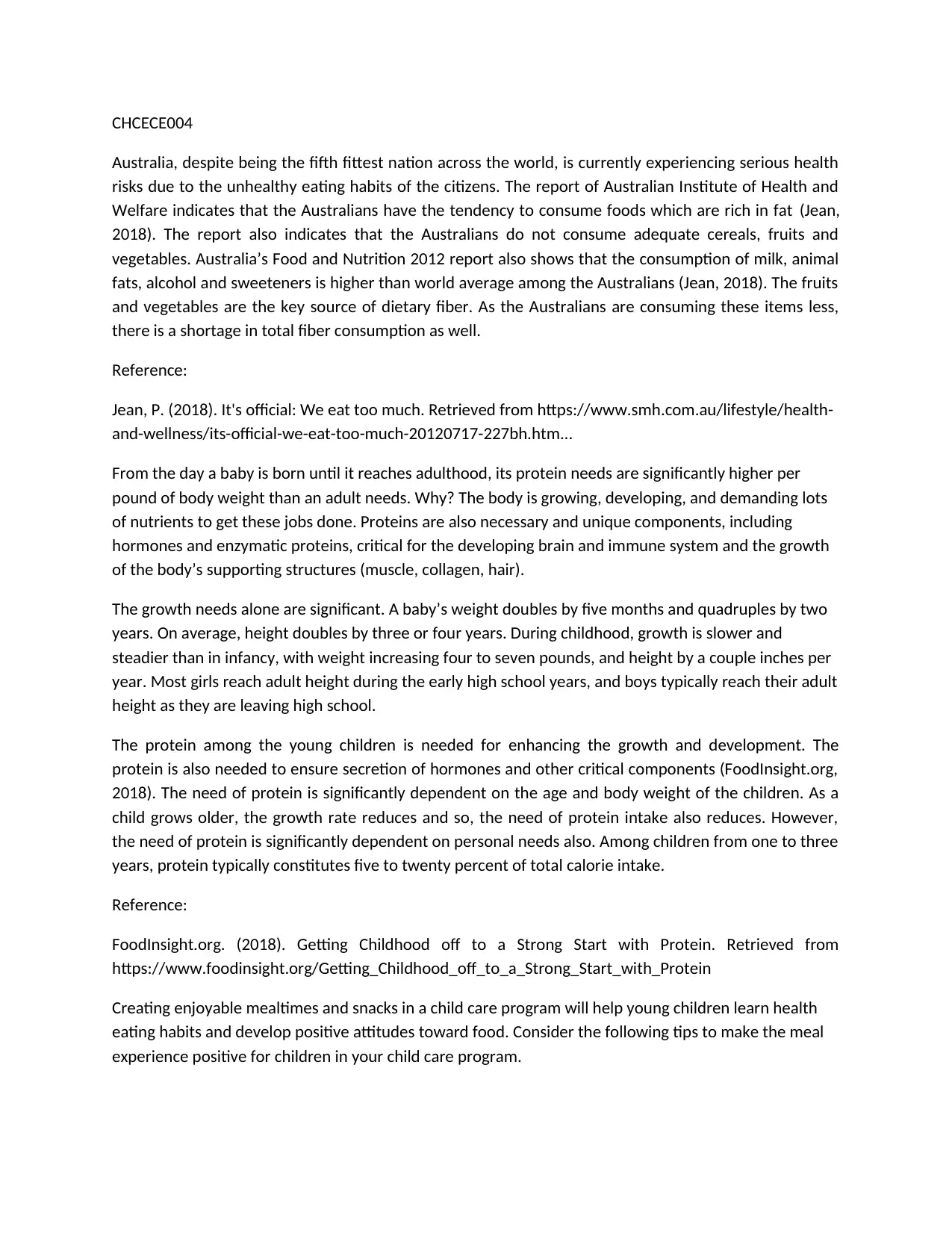
CHCECE004
Australia, despite being the fifth fittest nation across the world, is currently experiencing serious health
risks due to the unhealthy eating habits of the citizens. The report of Australian Institute of Health and
Welfare indicates that the Australians have the tendency to consume foods which are rich in fat (Jean,
2018). The report also indicates that the Australians do not consume adequate cereals, fruits and
vegetables. Australia’s Food and Nutrition 2012 report also shows that the consumption of milk, animal
fats, alcohol and sweeteners is higher than world average among the Australians (Jean, 2018). The fruits
and vegetables are the key source of dietary fiber. As the Australians are consuming these items less,
there is a shortage in total fiber consumption as well.
Reference:
Jean, P. (2018). It's official: We eat too much. Retrieved from https://www.smh.com.au/lifestyle/health-
and-wellness/its-official-we-eat-too-much-20120717-227bh.htm...
From the day a baby is born until it reaches adulthood, its protein needs are significantly higher per
pound of body weight than an adult needs. Why? The body is growing, developing, and demanding lots
of nutrients to get these jobs done. Proteins are also necessary and unique components, including
hormones and enzymatic proteins, critical for the developing brain and immune system and the growth
of the body’s supporting structures (muscle, collagen, hair).
The growth needs alone are significant. A baby’s weight doubles by five months and quadruples by two
years. On average, height doubles by three or four years. During childhood, growth is slower and
steadier than in infancy, with weight increasing four to seven pounds, and height by a couple inches per
year. Most girls reach adult height during the early high school years, and boys typically reach their adult
height as they are leaving high school.
The protein among the young children is needed for enhancing the growth and development. The
protein is also needed to ensure secretion of hormones and other critical components (FoodInsight.org,
2018). The need of protein is significantly dependent on the age and body weight of the children. As a
child grows older, the growth rate reduces and so, the need of protein intake also reduces. However,
the need of protein is significantly dependent on personal needs also. Among children from one to three
years, protein typically constitutes five to twenty percent of total calorie intake.
Reference:
FoodInsight.org. (2018). Getting Childhood off to a Strong Start with Protein. Retrieved from
https://www.foodinsight.org/Getting_Childhood_off_to_a_Strong_Start_with_Protein
Creating enjoyable mealtimes and snacks in a child care program will help young children learn health
eating habits and develop positive attitudes toward food. Consider the following tips to make the meal
experience positive for children in your child care program.
Australia, despite being the fifth fittest nation across the world, is currently experiencing serious health
risks due to the unhealthy eating habits of the citizens. The report of Australian Institute of Health and
Welfare indicates that the Australians have the tendency to consume foods which are rich in fat (Jean,
2018). The report also indicates that the Australians do not consume adequate cereals, fruits and
vegetables. Australia’s Food and Nutrition 2012 report also shows that the consumption of milk, animal
fats, alcohol and sweeteners is higher than world average among the Australians (Jean, 2018). The fruits
and vegetables are the key source of dietary fiber. As the Australians are consuming these items less,
there is a shortage in total fiber consumption as well.
Reference:
Jean, P. (2018). It's official: We eat too much. Retrieved from https://www.smh.com.au/lifestyle/health-
and-wellness/its-official-we-eat-too-much-20120717-227bh.htm...
From the day a baby is born until it reaches adulthood, its protein needs are significantly higher per
pound of body weight than an adult needs. Why? The body is growing, developing, and demanding lots
of nutrients to get these jobs done. Proteins are also necessary and unique components, including
hormones and enzymatic proteins, critical for the developing brain and immune system and the growth
of the body’s supporting structures (muscle, collagen, hair).
The growth needs alone are significant. A baby’s weight doubles by five months and quadruples by two
years. On average, height doubles by three or four years. During childhood, growth is slower and
steadier than in infancy, with weight increasing four to seven pounds, and height by a couple inches per
year. Most girls reach adult height during the early high school years, and boys typically reach their adult
height as they are leaving high school.
The protein among the young children is needed for enhancing the growth and development. The
protein is also needed to ensure secretion of hormones and other critical components (FoodInsight.org,
2018). The need of protein is significantly dependent on the age and body weight of the children. As a
child grows older, the growth rate reduces and so, the need of protein intake also reduces. However,
the need of protein is significantly dependent on personal needs also. Among children from one to three
years, protein typically constitutes five to twenty percent of total calorie intake.
Reference:
FoodInsight.org. (2018). Getting Childhood off to a Strong Start with Protein. Retrieved from
https://www.foodinsight.org/Getting_Childhood_off_to_a_Strong_Start_with_Protein
Creating enjoyable mealtimes and snacks in a child care program will help young children learn health
eating habits and develop positive attitudes toward food. Consider the following tips to make the meal
experience positive for children in your child care program.
Paraphrase This Document
Need a fresh take? Get an instant paraphrase of this document with our AI Paraphraser
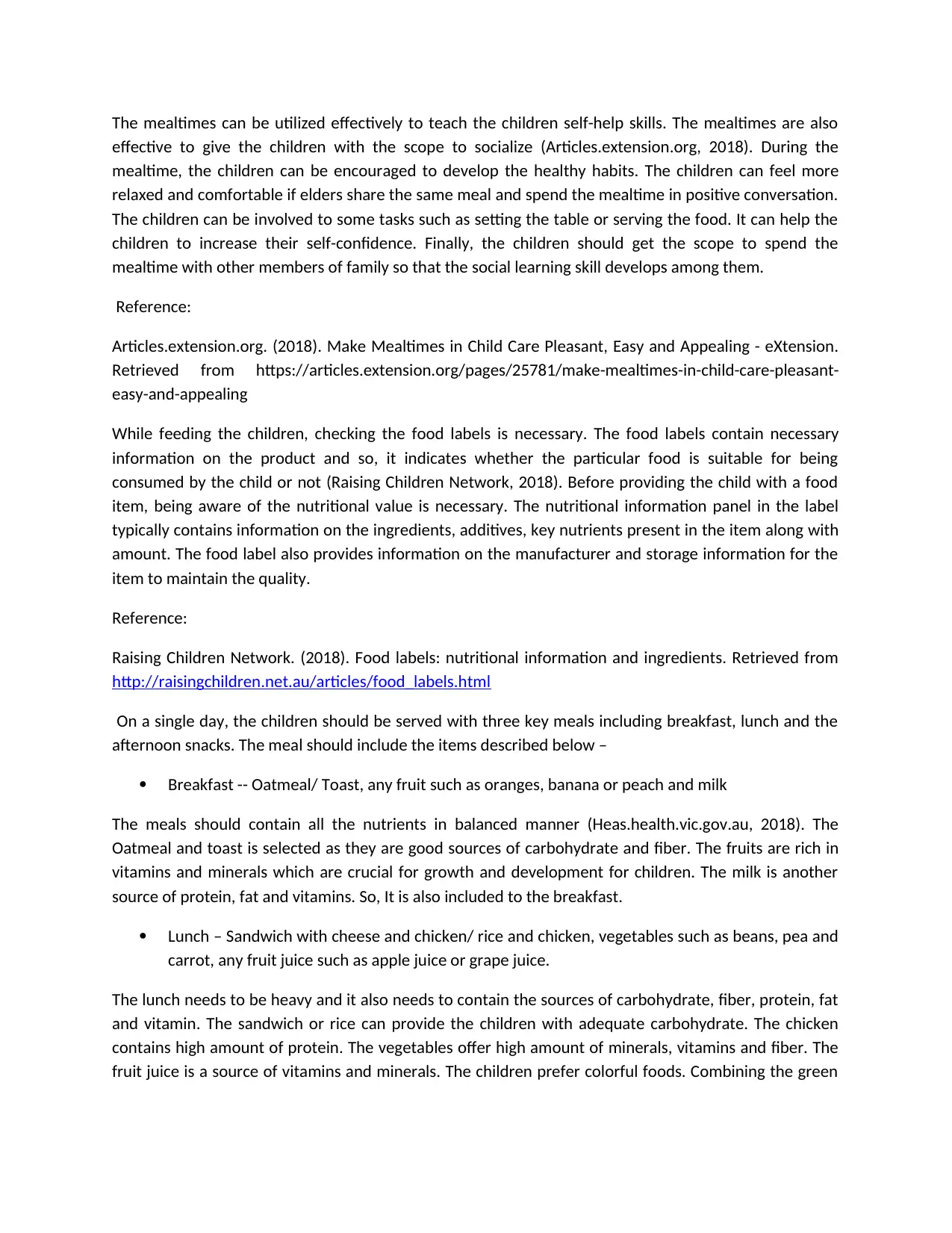
The mealtimes can be utilized effectively to teach the children self-help skills. The mealtimes are also
effective to give the children with the scope to socialize (Articles.extension.org, 2018). During the
mealtime, the children can be encouraged to develop the healthy habits. The children can feel more
relaxed and comfortable if elders share the same meal and spend the mealtime in positive conversation.
The children can be involved to some tasks such as setting the table or serving the food. It can help the
children to increase their self-confidence. Finally, the children should get the scope to spend the
mealtime with other members of family so that the social learning skill develops among them.
Reference:
Articles.extension.org. (2018). Make Mealtimes in Child Care Pleasant, Easy and Appealing - eXtension.
Retrieved from https://articles.extension.org/pages/25781/make-mealtimes-in-child-care-pleasant-
easy-and-appealing
While feeding the children, checking the food labels is necessary. The food labels contain necessary
information on the product and so, it indicates whether the particular food is suitable for being
consumed by the child or not (Raising Children Network, 2018). Before providing the child with a food
item, being aware of the nutritional value is necessary. The nutritional information panel in the label
typically contains information on the ingredients, additives, key nutrients present in the item along with
amount. The food label also provides information on the manufacturer and storage information for the
item to maintain the quality.
Reference:
Raising Children Network. (2018). Food labels: nutritional information and ingredients. Retrieved from
http://raisingchildren.net.au/articles/food_labels.html
On a single day, the children should be served with three key meals including breakfast, lunch and the
afternoon snacks. The meal should include the items described below –
Breakfast -- Oatmeal/ Toast, any fruit such as oranges, banana or peach and milk
The meals should contain all the nutrients in balanced manner (Heas.health.vic.gov.au, 2018). The
Oatmeal and toast is selected as they are good sources of carbohydrate and fiber. The fruits are rich in
vitamins and minerals which are crucial for growth and development for children. The milk is another
source of protein, fat and vitamins. So, It is also included to the breakfast.
Lunch – Sandwich with cheese and chicken/ rice and chicken, vegetables such as beans, pea and
carrot, any fruit juice such as apple juice or grape juice.
The lunch needs to be heavy and it also needs to contain the sources of carbohydrate, fiber, protein, fat
and vitamin. The sandwich or rice can provide the children with adequate carbohydrate. The chicken
contains high amount of protein. The vegetables offer high amount of minerals, vitamins and fiber. The
fruit juice is a source of vitamins and minerals. The children prefer colorful foods. Combining the green
effective to give the children with the scope to socialize (Articles.extension.org, 2018). During the
mealtime, the children can be encouraged to develop the healthy habits. The children can feel more
relaxed and comfortable if elders share the same meal and spend the mealtime in positive conversation.
The children can be involved to some tasks such as setting the table or serving the food. It can help the
children to increase their self-confidence. Finally, the children should get the scope to spend the
mealtime with other members of family so that the social learning skill develops among them.
Reference:
Articles.extension.org. (2018). Make Mealtimes in Child Care Pleasant, Easy and Appealing - eXtension.
Retrieved from https://articles.extension.org/pages/25781/make-mealtimes-in-child-care-pleasant-
easy-and-appealing
While feeding the children, checking the food labels is necessary. The food labels contain necessary
information on the product and so, it indicates whether the particular food is suitable for being
consumed by the child or not (Raising Children Network, 2018). Before providing the child with a food
item, being aware of the nutritional value is necessary. The nutritional information panel in the label
typically contains information on the ingredients, additives, key nutrients present in the item along with
amount. The food label also provides information on the manufacturer and storage information for the
item to maintain the quality.
Reference:
Raising Children Network. (2018). Food labels: nutritional information and ingredients. Retrieved from
http://raisingchildren.net.au/articles/food_labels.html
On a single day, the children should be served with three key meals including breakfast, lunch and the
afternoon snacks. The meal should include the items described below –
Breakfast -- Oatmeal/ Toast, any fruit such as oranges, banana or peach and milk
The meals should contain all the nutrients in balanced manner (Heas.health.vic.gov.au, 2018). The
Oatmeal and toast is selected as they are good sources of carbohydrate and fiber. The fruits are rich in
vitamins and minerals which are crucial for growth and development for children. The milk is another
source of protein, fat and vitamins. So, It is also included to the breakfast.
Lunch – Sandwich with cheese and chicken/ rice and chicken, vegetables such as beans, pea and
carrot, any fruit juice such as apple juice or grape juice.
The lunch needs to be heavy and it also needs to contain the sources of carbohydrate, fiber, protein, fat
and vitamin. The sandwich or rice can provide the children with adequate carbohydrate. The chicken
contains high amount of protein. The vegetables offer high amount of minerals, vitamins and fiber. The
fruit juice is a source of vitamins and minerals. The children prefer colorful foods. Combining the green
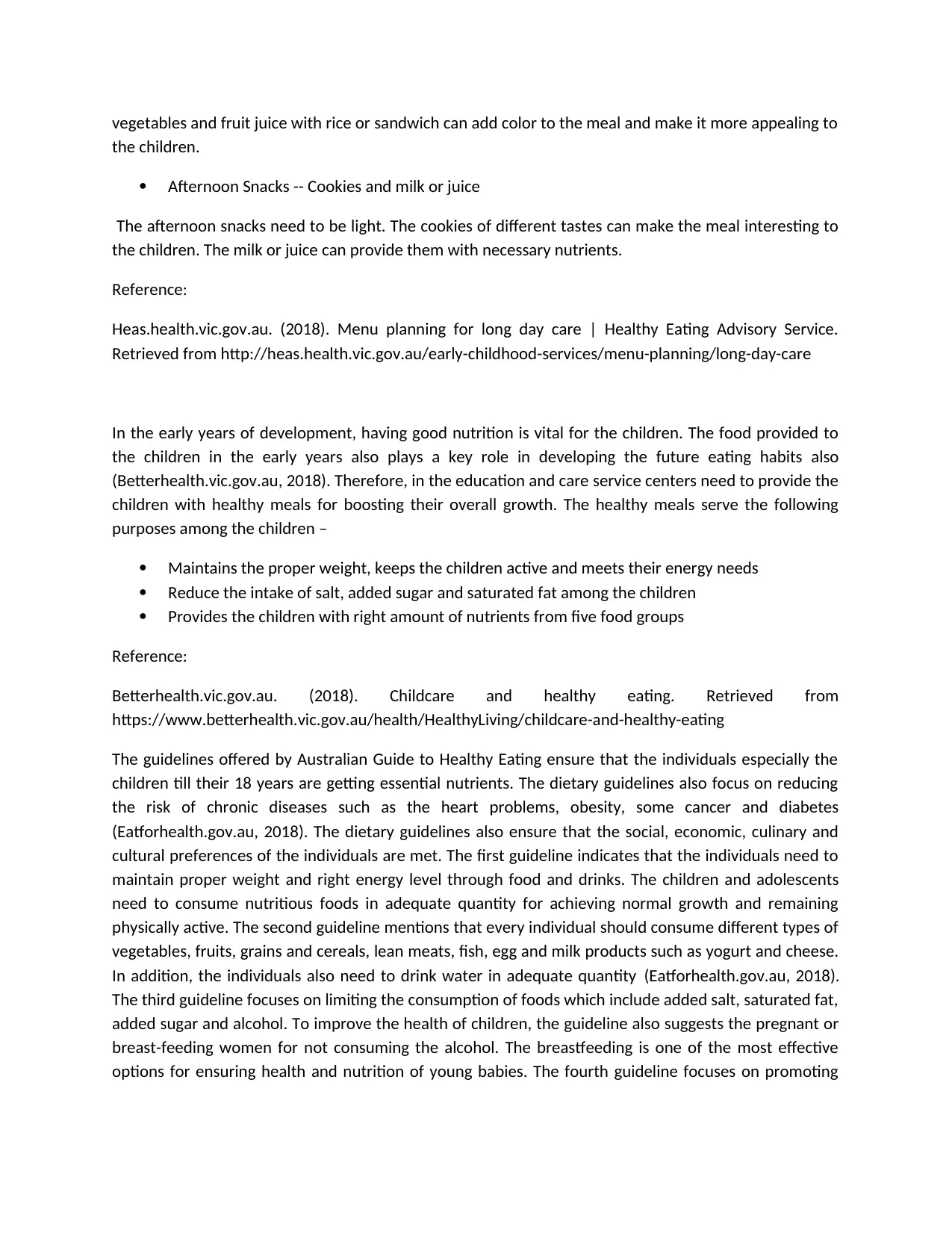
vegetables and fruit juice with rice or sandwich can add color to the meal and make it more appealing to
the children.
Afternoon Snacks -- Cookies and milk or juice
The afternoon snacks need to be light. The cookies of different tastes can make the meal interesting to
the children. The milk or juice can provide them with necessary nutrients.
Reference:
Heas.health.vic.gov.au. (2018). Menu planning for long day care | Healthy Eating Advisory Service.
Retrieved from http://heas.health.vic.gov.au/early-childhood-services/menu-planning/long-day-care
In the early years of development, having good nutrition is vital for the children. The food provided to
the children in the early years also plays a key role in developing the future eating habits also
(Betterhealth.vic.gov.au, 2018). Therefore, in the education and care service centers need to provide the
children with healthy meals for boosting their overall growth. The healthy meals serve the following
purposes among the children –
Maintains the proper weight, keeps the children active and meets their energy needs
Reduce the intake of salt, added sugar and saturated fat among the children
Provides the children with right amount of nutrients from five food groups
Reference:
Betterhealth.vic.gov.au. (2018). Childcare and healthy eating. Retrieved from
https://www.betterhealth.vic.gov.au/health/HealthyLiving/childcare-and-healthy-eating
The guidelines offered by Australian Guide to Healthy Eating ensure that the individuals especially the
children till their 18 years are getting essential nutrients. The dietary guidelines also focus on reducing
the risk of chronic diseases such as the heart problems, obesity, some cancer and diabetes
(Eatforhealth.gov.au, 2018). The dietary guidelines also ensure that the social, economic, culinary and
cultural preferences of the individuals are met. The first guideline indicates that the individuals need to
maintain proper weight and right energy level through food and drinks. The children and adolescents
need to consume nutritious foods in adequate quantity for achieving normal growth and remaining
physically active. The second guideline mentions that every individual should consume different types of
vegetables, fruits, grains and cereals, lean meats, fish, egg and milk products such as yogurt and cheese.
In addition, the individuals also need to drink water in adequate quantity (Eatforhealth.gov.au, 2018).
The third guideline focuses on limiting the consumption of foods which include added salt, saturated fat,
added sugar and alcohol. To improve the health of children, the guideline also suggests the pregnant or
breast-feeding women for not consuming the alcohol. The breastfeeding is one of the most effective
options for ensuring health and nutrition of young babies. The fourth guideline focuses on promoting
the children.
Afternoon Snacks -- Cookies and milk or juice
The afternoon snacks need to be light. The cookies of different tastes can make the meal interesting to
the children. The milk or juice can provide them with necessary nutrients.
Reference:
Heas.health.vic.gov.au. (2018). Menu planning for long day care | Healthy Eating Advisory Service.
Retrieved from http://heas.health.vic.gov.au/early-childhood-services/menu-planning/long-day-care
In the early years of development, having good nutrition is vital for the children. The food provided to
the children in the early years also plays a key role in developing the future eating habits also
(Betterhealth.vic.gov.au, 2018). Therefore, in the education and care service centers need to provide the
children with healthy meals for boosting their overall growth. The healthy meals serve the following
purposes among the children –
Maintains the proper weight, keeps the children active and meets their energy needs
Reduce the intake of salt, added sugar and saturated fat among the children
Provides the children with right amount of nutrients from five food groups
Reference:
Betterhealth.vic.gov.au. (2018). Childcare and healthy eating. Retrieved from
https://www.betterhealth.vic.gov.au/health/HealthyLiving/childcare-and-healthy-eating
The guidelines offered by Australian Guide to Healthy Eating ensure that the individuals especially the
children till their 18 years are getting essential nutrients. The dietary guidelines also focus on reducing
the risk of chronic diseases such as the heart problems, obesity, some cancer and diabetes
(Eatforhealth.gov.au, 2018). The dietary guidelines also ensure that the social, economic, culinary and
cultural preferences of the individuals are met. The first guideline indicates that the individuals need to
maintain proper weight and right energy level through food and drinks. The children and adolescents
need to consume nutritious foods in adequate quantity for achieving normal growth and remaining
physically active. The second guideline mentions that every individual should consume different types of
vegetables, fruits, grains and cereals, lean meats, fish, egg and milk products such as yogurt and cheese.
In addition, the individuals also need to drink water in adequate quantity (Eatforhealth.gov.au, 2018).
The third guideline focuses on limiting the consumption of foods which include added salt, saturated fat,
added sugar and alcohol. To improve the health of children, the guideline also suggests the pregnant or
breast-feeding women for not consuming the alcohol. The breastfeeding is one of the most effective
options for ensuring health and nutrition of young babies. The fourth guideline focuses on promoting
⊘ This is a preview!⊘
Do you want full access?
Subscribe today to unlock all pages.

Trusted by 1+ million students worldwide
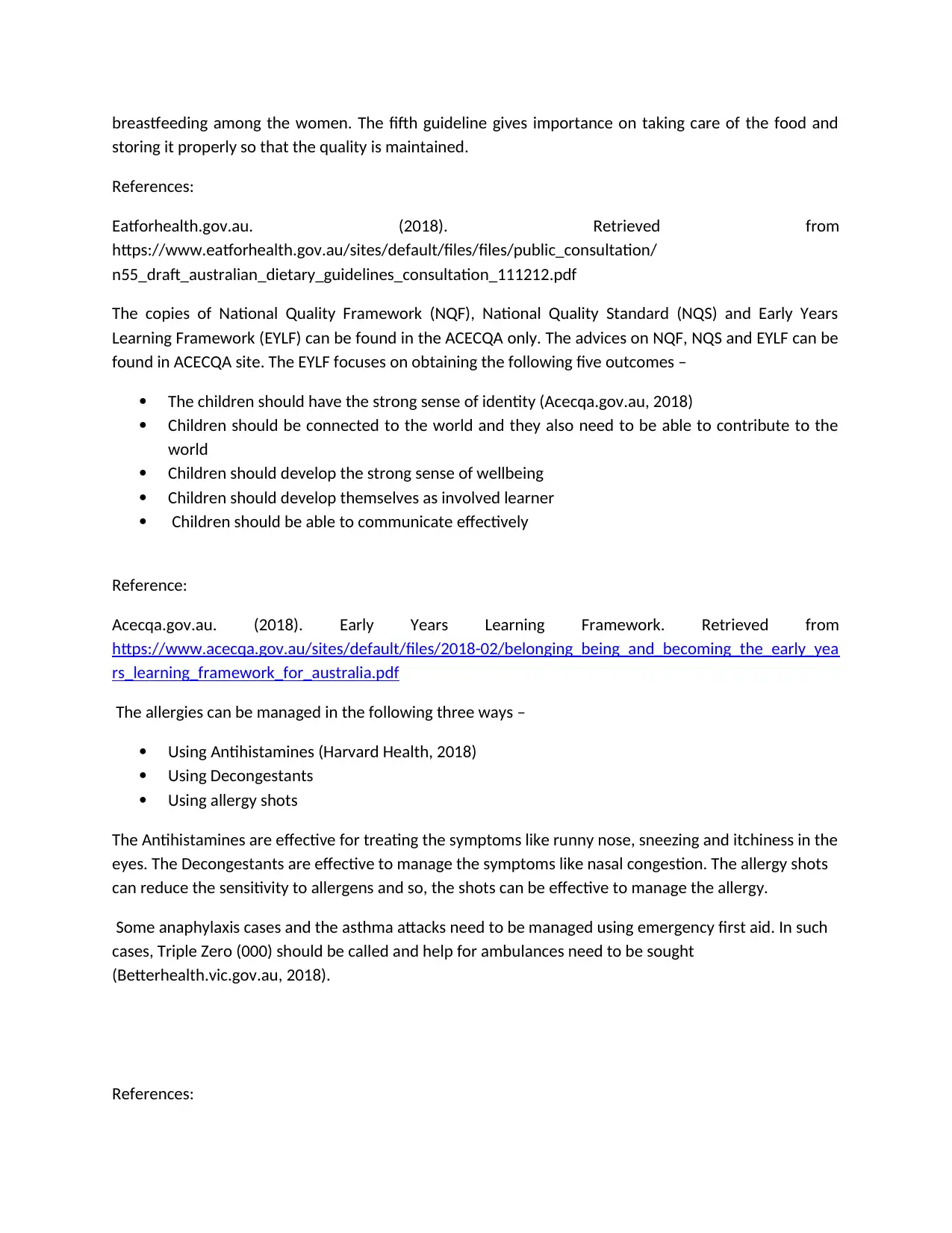
breastfeeding among the women. The fifth guideline gives importance on taking care of the food and
storing it properly so that the quality is maintained.
References:
Eatforhealth.gov.au. (2018). Retrieved from
https://www.eatforhealth.gov.au/sites/default/files/files/public_consultation/
n55_draft_australian_dietary_guidelines_consultation_111212.pdf
The copies of National Quality Framework (NQF), National Quality Standard (NQS) and Early Years
Learning Framework (EYLF) can be found in the ACECQA only. The advices on NQF, NQS and EYLF can be
found in ACECQA site. The EYLF focuses on obtaining the following five outcomes –
The children should have the strong sense of identity (Acecqa.gov.au, 2018)
Children should be connected to the world and they also need to be able to contribute to the
world
Children should develop the strong sense of wellbeing
Children should develop themselves as involved learner
Children should be able to communicate effectively
Reference:
Acecqa.gov.au. (2018). Early Years Learning Framework. Retrieved from
https://www.acecqa.gov.au/sites/default/files/2018-02/belonging_being_and_becoming_the_early_yea
rs_learning_framework_for_australia.pdf
The allergies can be managed in the following three ways –
Using Antihistamines (Harvard Health, 2018)
Using Decongestants
Using allergy shots
The Antihistamines are effective for treating the symptoms like runny nose, sneezing and itchiness in the
eyes. The Decongestants are effective to manage the symptoms like nasal congestion. The allergy shots
can reduce the sensitivity to allergens and so, the shots can be effective to manage the allergy.
Some anaphylaxis cases and the asthma attacks need to be managed using emergency first aid. In such
cases, Triple Zero (000) should be called and help for ambulances need to be sought
(Betterhealth.vic.gov.au, 2018).
References:
storing it properly so that the quality is maintained.
References:
Eatforhealth.gov.au. (2018). Retrieved from
https://www.eatforhealth.gov.au/sites/default/files/files/public_consultation/
n55_draft_australian_dietary_guidelines_consultation_111212.pdf
The copies of National Quality Framework (NQF), National Quality Standard (NQS) and Early Years
Learning Framework (EYLF) can be found in the ACECQA only. The advices on NQF, NQS and EYLF can be
found in ACECQA site. The EYLF focuses on obtaining the following five outcomes –
The children should have the strong sense of identity (Acecqa.gov.au, 2018)
Children should be connected to the world and they also need to be able to contribute to the
world
Children should develop the strong sense of wellbeing
Children should develop themselves as involved learner
Children should be able to communicate effectively
Reference:
Acecqa.gov.au. (2018). Early Years Learning Framework. Retrieved from
https://www.acecqa.gov.au/sites/default/files/2018-02/belonging_being_and_becoming_the_early_yea
rs_learning_framework_for_australia.pdf
The allergies can be managed in the following three ways –
Using Antihistamines (Harvard Health, 2018)
Using Decongestants
Using allergy shots
The Antihistamines are effective for treating the symptoms like runny nose, sneezing and itchiness in the
eyes. The Decongestants are effective to manage the symptoms like nasal congestion. The allergy shots
can reduce the sensitivity to allergens and so, the shots can be effective to manage the allergy.
Some anaphylaxis cases and the asthma attacks need to be managed using emergency first aid. In such
cases, Triple Zero (000) should be called and help for ambulances need to be sought
(Betterhealth.vic.gov.au, 2018).
References:
Paraphrase This Document
Need a fresh take? Get an instant paraphrase of this document with our AI Paraphraser
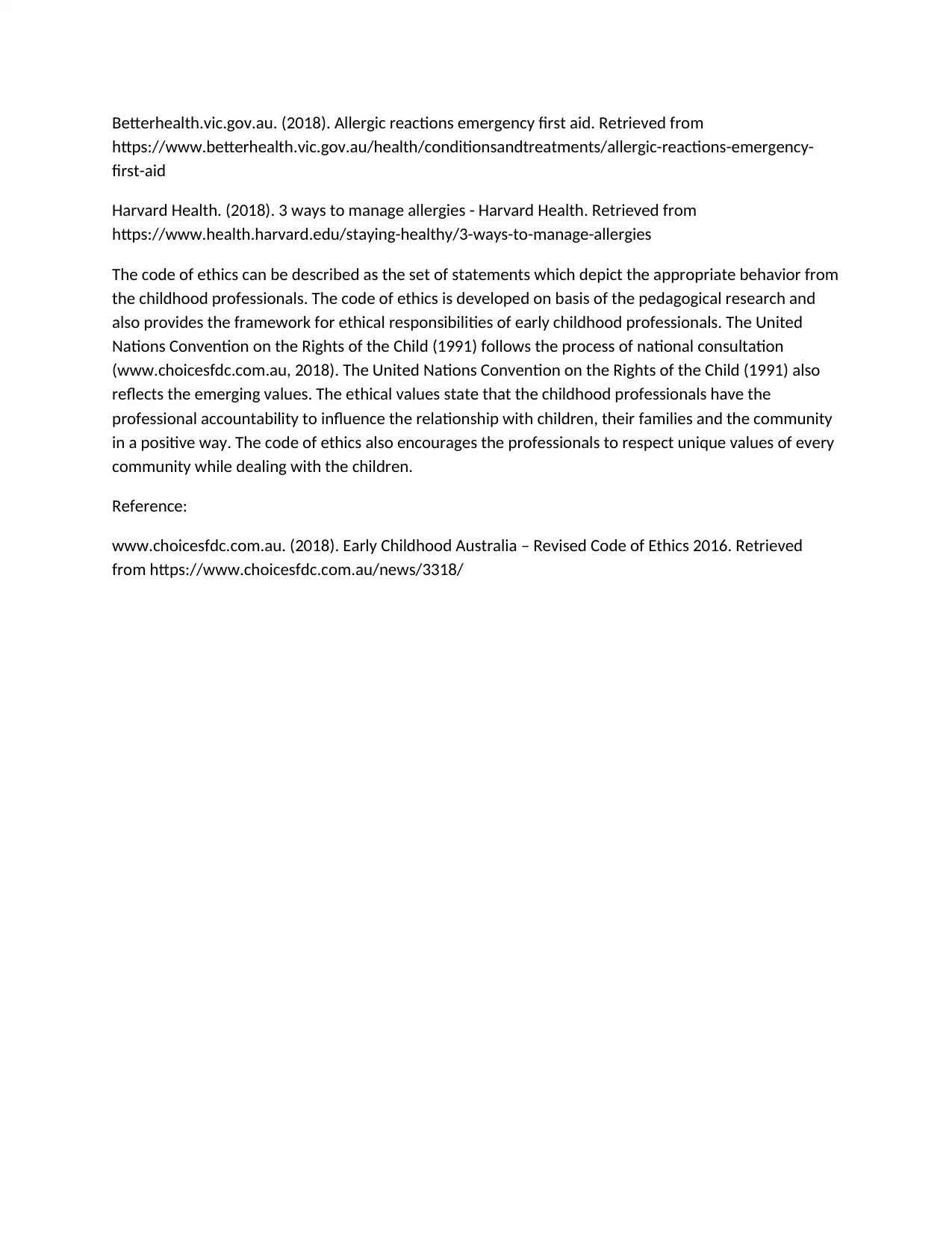
Betterhealth.vic.gov.au. (2018). Allergic reactions emergency first aid. Retrieved from
https://www.betterhealth.vic.gov.au/health/conditionsandtreatments/allergic-reactions-emergency-
first-aid
Harvard Health. (2018). 3 ways to manage allergies - Harvard Health. Retrieved from
https://www.health.harvard.edu/staying-healthy/3-ways-to-manage-allergies
The code of ethics can be described as the set of statements which depict the appropriate behavior from
the childhood professionals. The code of ethics is developed on basis of the pedagogical research and
also provides the framework for ethical responsibilities of early childhood professionals. The United
Nations Convention on the Rights of the Child (1991) follows the process of national consultation
(www.choicesfdc.com.au, 2018). The United Nations Convention on the Rights of the Child (1991) also
reflects the emerging values. The ethical values state that the childhood professionals have the
professional accountability to influence the relationship with children, their families and the community
in a positive way. The code of ethics also encourages the professionals to respect unique values of every
community while dealing with the children.
Reference:
www.choicesfdc.com.au. (2018). Early Childhood Australia – Revised Code of Ethics 2016. Retrieved
from https://www.choicesfdc.com.au/news/3318/
https://www.betterhealth.vic.gov.au/health/conditionsandtreatments/allergic-reactions-emergency-
first-aid
Harvard Health. (2018). 3 ways to manage allergies - Harvard Health. Retrieved from
https://www.health.harvard.edu/staying-healthy/3-ways-to-manage-allergies
The code of ethics can be described as the set of statements which depict the appropriate behavior from
the childhood professionals. The code of ethics is developed on basis of the pedagogical research and
also provides the framework for ethical responsibilities of early childhood professionals. The United
Nations Convention on the Rights of the Child (1991) follows the process of national consultation
(www.choicesfdc.com.au, 2018). The United Nations Convention on the Rights of the Child (1991) also
reflects the emerging values. The ethical values state that the childhood professionals have the
professional accountability to influence the relationship with children, their families and the community
in a positive way. The code of ethics also encourages the professionals to respect unique values of every
community while dealing with the children.
Reference:
www.choicesfdc.com.au. (2018). Early Childhood Australia – Revised Code of Ethics 2016. Retrieved
from https://www.choicesfdc.com.au/news/3318/
1 out of 5
Related Documents
Your All-in-One AI-Powered Toolkit for Academic Success.
+13062052269
info@desklib.com
Available 24*7 on WhatsApp / Email
![[object Object]](/_next/static/media/star-bottom.7253800d.svg)
Unlock your academic potential
Copyright © 2020–2025 A2Z Services. All Rights Reserved. Developed and managed by ZUCOL.





